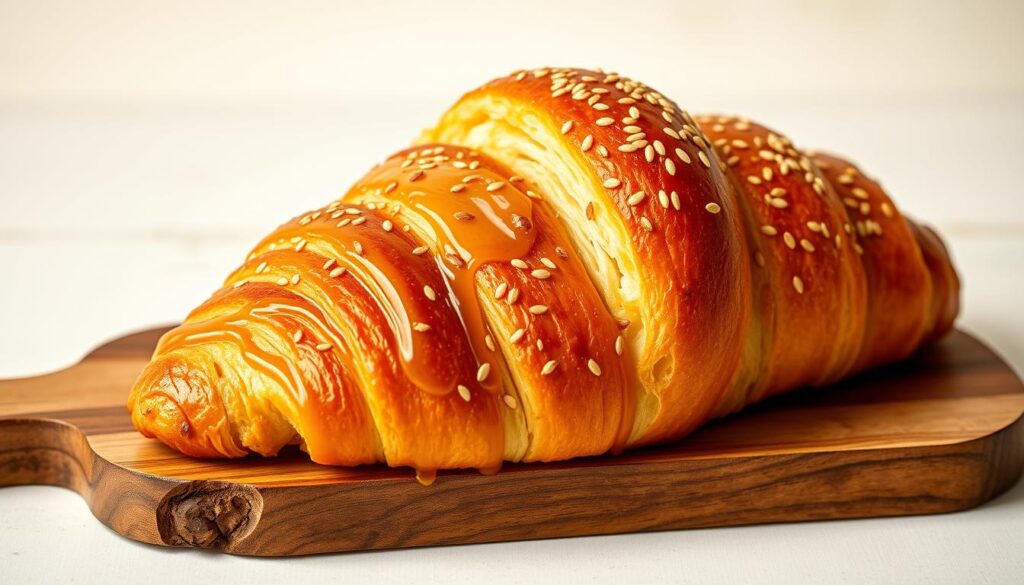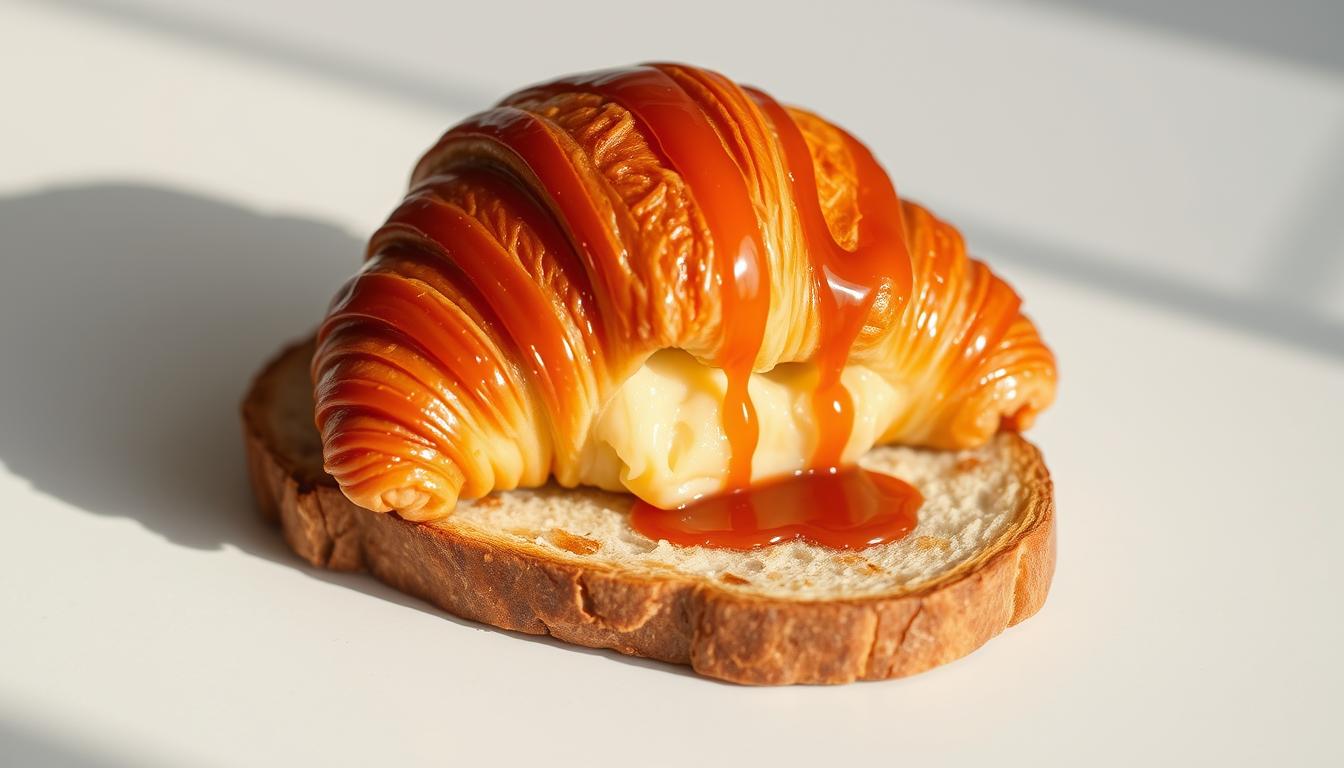Croissant Toast: The Perfect Morning Indulgence
Imagine starting your morning with a breakfast that’s both rich in flavor and utterly satisfying. Croissant toast is an indulgent breakfast delight, blending the buttery, flaky texture of croissant with the warm, creamy richness of French toast. This indulgent breakfast is perfect for weekend brunches, holiday breakfasts, or as a special treat.
Croissant toast boasts a tender, melt-in-your-mouth softness complemented by a crispy, flaky crust. The flavor is blissfully buttery and slightly sweet, making it a delightful twist on traditional breakfast bread. With its rich flavor profile and versatility, croissant toast is sure to become a new favorite breakfast recipe.
Table of Contents
What Makes Croissant Toast So Special
Croissant toast offers a delightful twist on traditional French toast, delivering a richer and more complex flavor. By using croissants instead of regular bread, you elevate the dish with layers of flaky, buttery goodness. This transformation brings a new level of sophistication to a classic breakfast favorite.
The Buttery Flaky Texture
The use of croissants in place of traditional bread is what sets croissant toast apart. The flaky layers of a croissant soak up the custard mixture beautifully, creating a rich, indulgent treat. As it cooks, the exterior crisps to a golden brown, while the interior stays soft and custard-like. This texture, paired with the rich, buttery flavor of the croissant, creates an irresistibly indulgent breakfast experience.
| Feature | Traditional French Toast | Croissant Toast |
|---|---|---|
| Bread Type | Regular bread | Croissants |
| Texture | Soft and uniform | Flaky and layered |
| Flavor Profile | Simple, eggy | Buttery, complex |
A Twist on Traditional French Toast
Croissant toast recipe is an evolution of the classic French toast, also known as eggy bread or pain perdu. While traditional French toast is made with regular bread, croissant toast uses the flaky, buttery croissant. This change transforms the dish, adding a new level of complexity to the flavor and texture. The preparation method remains similar, involving soaking the bread in a mixture of egg and milk, then cooking it on heat until golden brown.
Using croissants adds a touch of elegance to your breakfast without requiring much extra effort. This makes croissant toast an ideal choice for those looking to elevate their breakfast routine with a delicious and relatively quick recipe.
Essential Ingredients for Croissant Toast
The foundation of a delicious croissant toast lies in its essential components. Creating this indulgent breakfast begins with two key components: the croissant base and the rich custard mixture.
The Bread Options
When it comes to choosing the right bread for your croissant toast, you have two main options: using a croissant bread loaf or individual croissants. Croissant bread loaf is ideal for making multiple servings at once, while individual croissants offer more control over portion sizes.
Using Croissant Bread Loaf
A croissant bread loaf is perfect for a crowd or for making a batch of croissant toast to enjoy throughout the week. Simply slice the loaf into thick pieces, and you’re ready to go.
Using Individual Croissants
Using individual croissants allows you to customize each piece to your liking. This choice is perfect for creating a more personalized breakfast experience.
The Perfect Custard Mixture
To make the custard, combine whole milk, heavy cream, eggs, vanilla extract, brown sugar, cinnamon, and a pinch of salt. In a bowl, whisk the ingredients until they are completely combined. Maintaining the perfect egg-to-milk ratio is essential for the desired custard consistency.
In a bowl, whisk 2 eggs with 1 cup of whole milk and ½ cup of heavy cream to prepare the custard mixture. Stir 1 teaspoon of vanilla, 2 tablespoons of brown sugar, 1/2 teaspoon of cinnamon, and a pinch of salt. Whisk the mixture until it’s smooth and creamy.

With the right ingredients and proper proportions, you can create a rich and indulgent croissant toast that’s sure to impress.
How to Make Croissant Toast: Step-by-Step
The process of making croissant toast is straightforward and requires minimal ingredients. To start, you’ll need to prepare your croissants, create a custard mixture, soak the croissants, and then cook them to a golden brown perfection.
Preparing Your Croissants
Begin by slicing your croissants into thick pieces, about 1-2 inches. You can use day-old croissants for this recipe, as they will hold up better to the soaking process. Arrange the sliced croissants on a plate or tray, prepared for soaking in the custard mixture
Creating the Custard Mixture
In a large bowl, whisk together the eggs, milk, sugar, and a pinch of salt until the mixture is smooth and thoroughly combined. The mixture should be smooth and well combined. Incorporate a teaspoon of vanilla extract to deepen the flavor.

The Soaking Process
Immerse each croissant piece in the custard mixture, making sure both sides are fully coated. Ensure they’re fully soaked without becoming too fragile. Move the custard-soaked croissant pieces onto a separate plate or tray.
Cooking to Golden Perfection
Warm a nonstick skillet over medium-low heat and melt in a small pat of butter. Lay the soaked croissant pieces cut side down in the pan. Cook for 3 to 4 minutes, until the bottoms develop a golden-brown color. Flip them over and cook for another 2 minutes. Adjust the heat as needed to avoid over-browning the surface—aim for a golden brown finish with the center cooked through.
- Cook the croissant toast over medium-low heat to allow for gentle cooking and avoid burning.
- Use a nonstick pan to prevent the toast from sticking and to make it easier to flip.
- Don’t overcrowd the pan—cook in batches if necessary.
By following these steps and controlling the cooking time and heat, you’ll achieve perfectly cooked croissant toast with a delicious, golden brown exterior and a warm, fluffy interior.
Expert Tips for the Best Croissant Toast
To take your croissant toast to the next level, follow these expert suggestions that cover the crucial aspects of preparation. Mastering the art of croissant toast involves understanding the importance of the bread you use, the time you allow for soaking, and the technique for cooking it to perfection.
Controlling the Heat
One of the most critical factors in making exceptional croissant toast is controlling the heat. You want to cook your croissants over medium heat, ensuring that they cook evenly without burning at the edge. A good non-stick pan is essential for this step, as it allows you to cook the croissant toast without it sticking and tearing.
The Ideal Soaking Time
The duration for which you soak the bread in the custard mixture is very important. You want the loaf to absorb the mixture evenly but not become too soggy. Typically, soaking each side for about 30 seconds to 1 minute is ideal, depending on the freshness of the croissants.
Working with Day-Old Croissants
Using day-old croissants is highly recommended for making croissant toast because they hold up better to the custard mixture without falling apart. If you don’t have day-old bread, you can dry out fresh croissants slightly in a low oven to achieve a similar effect. This step is crucial for achieving the perfect texture in your final recipe.
| Tip | Description | Benefit |
|---|---|---|
| Control the Heat | Cook over medium heat | Even cooking without burning |
| Ideal Soaking Time | Soak for 30 seconds to 1 minute | Even absorption without sogginess |
| Use Day-Old Croissants | Dry out fresh croissants if necessary | Better texture and less likelihood of falling apart |
Delicious Variations and Toppings
Transform your breakfast with creative and mouth-watering croissant toast variations. The key to making your croissant toast stand out lies in the toppings and variations you choose.
Classic Toppings
Start with the classics to elevate your croissant toast. A simple yet effective option is a dusting of cinnamon sugar on top, adding a sweet and crunchy texture. You can also enjoy it with a dollop of whipped cream for a richer treat. For a more traditional approach, a sprinkle of plain sugar will enhance the flavor without overpowering it.
Fruit and Nut Combinations
For a fresher take, consider adding fruit and nut combinations to your toast. Sliced bananas or berries paired with a sprinkle of chopped nuts not only add natural sweetness but also provide a satisfying crunch. The addition of a hint of vanilla can further enhance the flavor profile, making it a delightful serving suggestion for any meal.
Decadent Dessert-Style Options
If you’re looking to indulge, transform your croissant toast into a dessert-worthy treat. Drizzle it with chocolate sauce or caramel to give it a luxurious twist. Adding a dollop of flavored whipped cream or a sprinkle of cinnamon sugar on top can elevate the dish. Trying a pinch of salt or swapping in a different extract, such as almond, can add a distinctive twist to the flavor.
Conclusion: Elevate Your Breakfast Routine with Croissant Toast
Elevate your morning routine with the rich, buttery goodness of croissant toast. This delightful twist on a classic favorite combines the flaky, buttery texture of croissants with the warm, custardy goodness of French toast, making it a perfect dish for any occasion.
By following the key techniques outlined, you can ensure perfect croissant toast every time. Experiment with various toppings and ingredients to make the recipe your own. Whether it’s a holiday brunch, a weekend family breakfast, or just a special treat, croissant toast is sure to impress.
With its simple yet luxurious ingredients, including butter, eggs, and milk, this dish transforms an ordinary morning into something special. So, today, give croissant toast a try and experience the joy of a perfectly cooked, golden-brown breakfast treat. Share your variations and experiences, and enjoy the delight of croissant toast with your loved ones.
FAQ
What type of bread is best for making croissant French toast?
Can I use whole milk and heavy cream in the custard mixture?
How long should the bread sit in the custard mixture to soak properly?
What’s the best heat setting for cooking croissant French toast?
Can I top my croissant French toast with whipped cream and cinnamon sugar?
How do I prevent the bread from becoming too soggy or too dry?
Can I make croissant French toast in advance?
Bake It. Love It. Tell Us About It.
Easy and delicious
This croissant toast is simply delicious—crispy, buttery, and full of flavor
So easy and ideal for brunch or a cozy morning treat.
Delicious and rich
This Croissant Toast was such a treat! The buttery layers turned golden and crisp, while the inside stayed soft and fluffy. It felt indulgent but so worth it — definitely a recipe I’ll be making again for a cozy breakfast.

